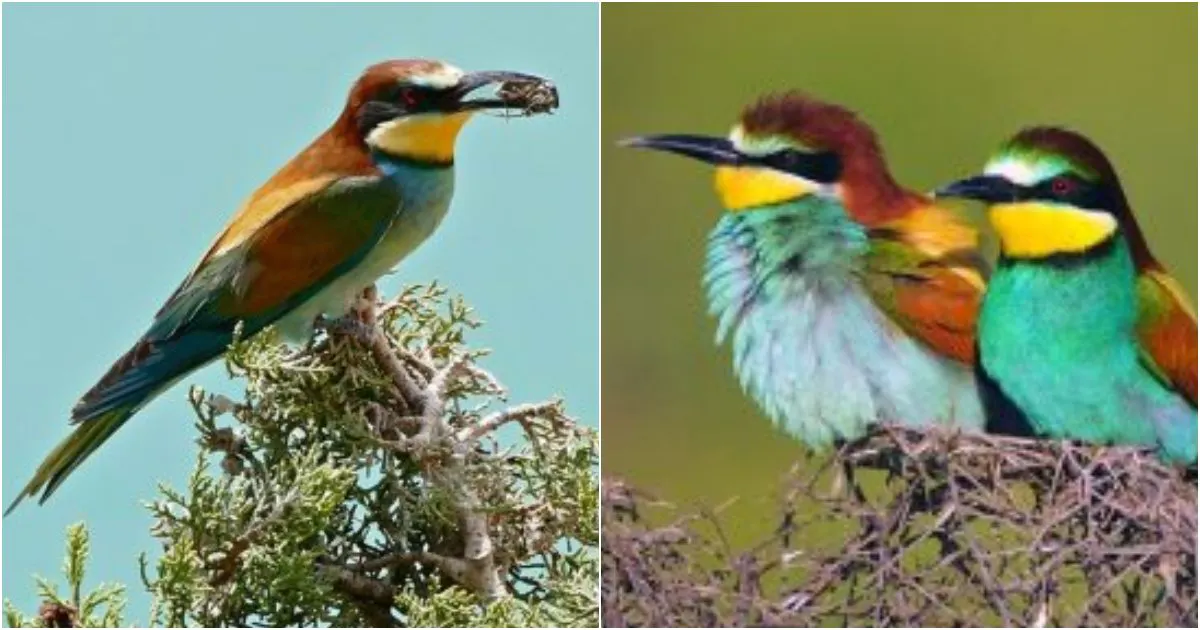Reveling in the Splendor of the European Bee-Eater: Unveiling Nature’s Masterpiece

In the realm of avian wonder, few species can rival the captivating allure of the European bee-eater (Merops apiaster). Prepare to be entranced by the resplendent display of colors that adorns this remarkable bird, especially during its enchanting breeding season. With each graceful movement, the European bee-eater showcases a tapestry of hues that seems almost too exquisite to be real.

At a mere glance, the bird’s distinctive features seize the gaze. Crowned by a rich brown cap, its head carries a breathtaking secret – a brilliant yellow forehead that radiates warmth and vibrancy. The eyes are drawn to the striking contrast of a deep black eye band, tracing its path from the bill’s base, under the eye, and extending almost elegantly to the nape of the neck. Just below the bill lies a captivating expanse of yellow, encircled by a defining black band. As our eyes journey further down, a captivating blend of green and blue plumage emerges, a chromatic symphony that stretches majestically to encompass the entirety of its tail. A spellbinding spectacle unfolds during flight, as a central spike formed by elongated feathers graces the tail, an artistic flourish enhancing its visual allure.
In a captivating play of nature’s artistry, female European bee-eaters share a kinship with their male counterparts. Yet, they bear a subtle distinction, with their scapulars and back adorned in a greener hue, while their throat and breast embrace a softer, paler palette in comparison.
As the avian world’s masterpiece unfolds, juvenile bee-eaters take their place in this symphony of color, presenting a more understated palette. Their brown eyes replace the vivid red of their adult counterparts, hinting at the transformations awaiting them on their journey to maturity.
A tale of their habitat is one of diverse landscapes. These splendid beings grace the canvas of various regions, from the fertile lands of southern and central Europe to the vast stretches of northern and southern Africa, even reaching out to select parts of Asia. While a resident population dwells in South Africa, the majority embark on a migratory sojourn to the tropical havens of Africa as winter sets in.
The European bee-eater’s preferred abodes are as diverse as their colors. They find sanctuary in the embrace of river valleys, where nature’s pulse beats strongest. Cultivated areas adorned with trees offer solace, while pastures and plains become their theater of existence. Even semi-desert regions, adorned with shrubbery, become a haven for their vibrant presence.
As the stage shifts to culinary preferences, the European bee-eater assumes the role of a skilled aerial hunter. With mesmerizing precision, it dines on a feast of insects, with bees taking center stage. The menu extends to include wasps, locusts, and dragonflies – a testament to their prowess in securing sustenance from the sky.
In the tapestry of existence, challenges and triumphs interlace. As European bee-eaters navigate the terrain of existence, they encounter pressures in the form of hunting, driven by their perceived pest status. Yet, against this backdrop, their essence remains resilient. The guardians of biodiversity recognize their significance, and thus, the IUCN Red List acknowledges them as a species of Least Concern, a testament to their population’s enduring stability.










